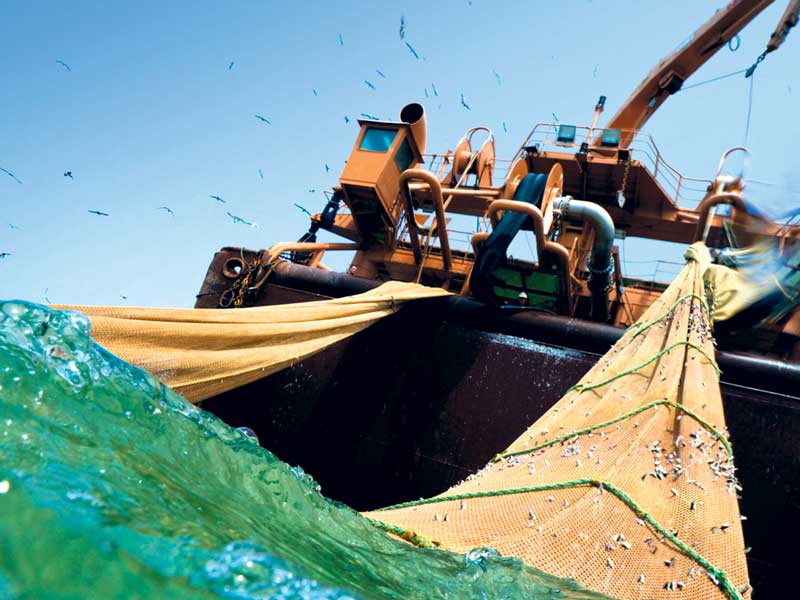Fishy business: cameras onboard commercial vessels delayed
6 min read
Conservationists are calling for cameras onboard to effectively monitor the fishing industry and to have an accurate picture of bycatch. Photo: © Christian Aslund | Greenpeace
By the end of June, New Zealand fishing boats were supposed to carry cameras. Then, the deadline was extended. And this isn’t the first time the rollout date has been moved since cameras were first proposed by the National-led government following concerns over illegal fish dumping.
Critics condemn it. The opposition says it is another case of NZ First undermining Labour and Greens. However, in a recent statement released, NZ First said it was fisheries minister Stuart Nash’s office that “asked to delay the introduction of cameras on boats”.
“As the fisheries minister Stuart Nash will attest, New Zealand First raised legitimate concerns about cameras on boats, namely their cost and who would be able to access the data,” said party leader Winston Peters.
“It is vital that sound policy has sound implementation. We are not going to be putting fishing boats, crew, and families out of business because of thoughtless bureaucracy.”
When asked by Stuff if NZ First supported the government’s efforts, Nash said, “Yeah sure.” “It’s just not possible to do next month … I’ve been very clear that I want to drive change for the fishing industry.”
Continued delay ‘unjustified’
Although the Labour-led coalition says they need more time to carry out the installation of monitoring cameras, organisations such as Greenpeace and WWF-New Zealand are not happy with yet another delay. The government says the technology, already installed on a few boats in the West Coast, is not yet ready for wider distribution and so the ‘holding date’ was moved earlier in June from 1 July 2020 to 1 October 2021.
“The technology is ready and proven, and we also believe the government is ready,” says Amanda Leathers, WWF-New Zealand marine species programme manager.
“Over the last year, the government has successfully rolled out electronic catch reporting and geospatial position reporting, which shows they are completely capable of effectively managing a process to implement cameras now.”
And while the initial delay in the rollout of cameras was supported to ensure it was done in the right way, Leathers says the continued delay is “unjustified.”
“The issues that are still held up by the industry as barriers to the implementation of cameras, including cost and privacy issues, can be overcome. The government and industry know this. In similar fisheries operations in Australia, cameras on boats is standard, particularly to quantify the impact of fisheries on protected species.”
Stuff reported Nash saying that rolling out cameras right away would be too costly for smaller fishing operators to afford, and while Leathers says she agrees there is an outlay of costs, “the cost of inaction is far greater”.
“These costs include reputational costs, environmental costs, and financial costs when key markets move away from fisheries who can’t prove they’re working sustainably,” she says.
Greenpeace NZ adds there has been confusion on why the government hasn’t been able to get this done in time. “The minister of fisheries claimed it was for technology reasons, but the team leading the work said more consultation was needed before the technology needs could even be assessed. So, which is it?” says Jessica Desmond, oceans campaigner at Greenpeace Aotearoa.
Others, such as Forest & Bird, believe the real reason for ongoing delays is “political”. “Much of the of fishing industry is refusing to have cameras and the government lacks the political will to require them to use cameras,” says Geoff Keey, Forest & Bird spokesperson.
“Forest & Bird has been calling for the government to fund the capital cost of rolling out cameras on commercial vessels as part of a COVID recovery for both people and planet. The country is spending billions on COVID recovery and it should invest in transforming our fishing sector as part of it.”
Industry speaks out
When asked by Fishing & Outdoors if Seafood NZ – the company that works closely with the seafood industry – was in favour of the government’s proposal, chief executive Jeremy Helson said the industry is not opposed to it.
“Many fishermen already voluntarily have cameras onboard and cameras are also on vessels in high-risk areas such as the Hauraki Gulf, where the Black Petrel is found and off the west coast of New Zealand in Māui dolphin territory,” says Helson.
He added the delay is not something the fishing industry has any say over but is in constant and ongoing talks with government to resolve some of the issues.
“These issues are around privacy on the vessel – which is the fishermen’s workplace – who will have access to the data that is collected, and what that data would be used for?” Helson says.
And then there is the question of who pays for the cameras. “If they are being put on vessels for compliance reasons, should that be a government cost? The average cost of these cameras is around $30,000 each and the majority of the inshore vessels are one to five people operations and they would struggle to afford that. There are also vessels that are too small to fit a camera, such as commercial paua-diving vessels and one-man flat fishing operations in our harbours.
“The continued discussions with the government are being conducted with goodwill on both sides, and we hope a resolution to some of the issues will be resolved in the near future.”
A spokesperson for fisheries minister was also quoted by The Spinoff saying the extension is a “purely administrative change.” “If this change is not made, fishers will not be able to fish legally from this date, potentially putting livelihoods at stake at a time of national crisis.”
Conservationists say monitoring essential
However, conservationists argue that cameras on boats across New Zealand commercial fleet are essential to effectively monitor the fishing industry and to have an accurate picture of bycatch.
“The commercial fishing industry likes to think it can monitor and regulate itself, but history shows us this hasn’t worked. We’ve had numerous cases of this industry being caught fish dumping, exceeding catch limits, and not reporting bycatch incidents,” Desmond says.
“We need to have monitoring in place across the board to ensure the rules are followed and the oceans protected.”
Leathers adds that without an established level of independent monitoring of fishing, there is no way to verify fishing is sustainable.
“We don’t know the level of impact fishing is having on protected species such as seabirds, seals, dolphins, and whales. “New Zealand’s fisheries reputation is already on shaky ground with only two percent observer coverage on inshore set-net fishery. Markets, here and abroad, are increasingly expecting and demanding proof of our sustainability, which puts our fisheries at risk. For example, the US will ban import of our fish, starting in 2021, if we do not meet their standards for management of fisheries impacts on marine mammals such as seals, whales, and dolphins.”
Leathers stresses that cameras on boats is the ready solution to achieve the level of monitoring necessary to ensure New Zealand is managing fisheries sustainably and offering proof to its key markets.
“Economic restraints and the health and safety concerns of COVID-19 prevents New Zealand from putting human observers on all boats. However, cameras are a fraction of the cost of human observers and
do not contract COVID or need to sleep.”
Forest & Bird adds often seabird bycatch is not reported unless there is an observer onboard. “Commercial fishers are required to keep accurate logbooks and can be fined $100,000 if they falsify their logbooks,” Keey says.
“Yet monitoring of seabird bycatch shows that commercial fishers often don’t report seabird bycatch unless there is an observer onboard. “We need cameras to verify logbooks and ensure fishers report accurately what they catch and what they discard. If a number of fishers aren’t reporting seabird bycatch when they are legally required to, it raises questions about whether those fishers are also failing to report discarding.”
Keey adds that “a transparent accountable fishing industry where the customer can have confidence that the fish was caught legally, sustainably, and appropriately is in everyone’s best interests.”
However, despite the delays, there is still no clear plan or process in place. The deadline may extend again. “The minister has alluded to the fact that even the 15-month delay is not a firm deadline. Who knows how long we’ll be kicking this can down the road, all while the health of our oceans and marine life lose out,” Desmond says.
“Ahead of the election in September, all eyes will be on which political parties will step on this and take it forward. Most New Zealanders, like those who fish recreationally, really want to see better protection for the oceans from commercial fishing. It’s really time those that represent us in government listened to them.”



